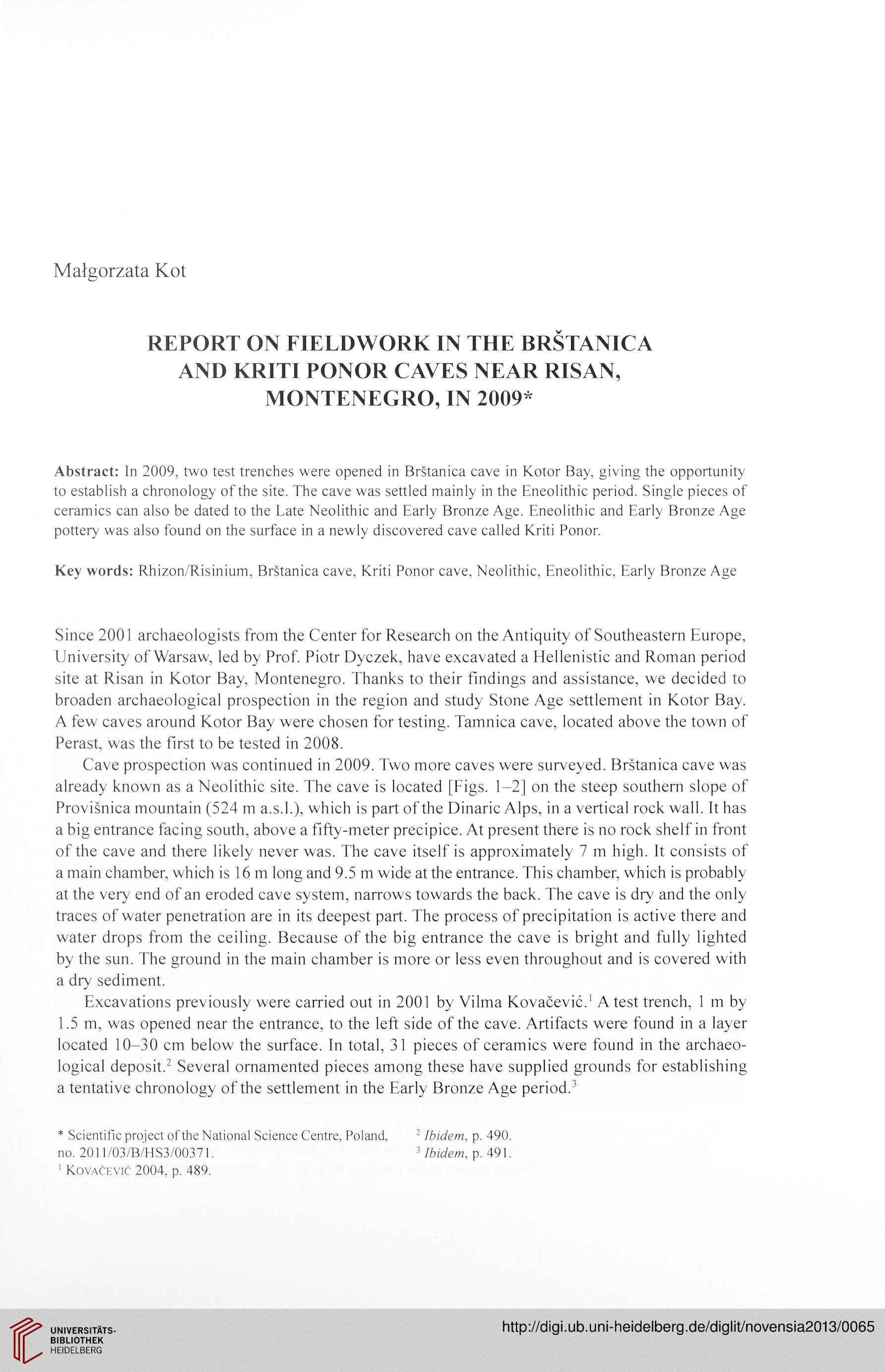Małgorzata Kot
REPORT ON FIELDWORK IN THE BRŚTANICA
AND KRITI PONOR CAVES NEAR RISAN,
MONTENEGRO, IN 2009*
Abstract: In 2009, two test trenches were opened in Brśtanica cave in Kotor Bay, giving the opportunity
to establish a chronology of the site. The cave was settled mainly in the Eneolithic period. Single pieces of
ceramics can also be dated to the Late Neolithic and Early Bronze Age. Eneolithic and Early Bronze Age
pottery was also found on the surface in a newly discovered cave called Kriti Ponor.
Key words: Rhizon/Risinium, Brśtanica cave, Kriti Ponor cave, Neolithic, Eneolithic, Early Bronze Age
Since 2001 archaeologists from the Center for Research on the Antiquity of Southeastern Europe,
University of Warsaw, led by Prof. Piotr Dyczek, have excavated a Hellenistic and Roman period
site at Risan in Kotor Bay, Montenegro. Thanks to their findings and assistance, we decided to
broaden archaeological prospection in the region and study Stone Age settlement in Kotor Bay.
A few caves around Kotor Bay were chosen for testing. Tamnica cave, located above the town of
Perast, was the first to be tested in 2008.
Cave prospection was continued in 2009. Two more caves were surveyed. Brśtanica cave was
already known as a Neolithic site. The cave is located [Figs. 1-2] on the steep southern slope of
Provisnica mountain (524 m a.s.l.), which is part of the Dinaric Alps, in a vertical rock wall. It has
a big entrance facing south, above a fifty-meter precipice. At present there is no rock shelf in front
of the cave and there likely never was. The cave itself is approximately 7 m high. It consists of
a main chamber, which is 16 m long and 9.5 m wide at the entrance. This chamber, which is probably
at the very end of an eroded cave system, narrows towards the back. The cave is dry and the only
traces of water penetration are in its deepest part. The process of precipitation is active there and
water drops from the ceiling. Because of the big entrance the cave is bright and fully lighted
by the sun. The ground in the main chamber is more or less even throughout and is covered with
a dry sediment.
Excavations previously were carried out in 2001 by Vilma Kovacevic.1 A test trench, 1 m by
1.5 m, was opened near the entrance, to the left side of the cave. Artifacts were found in a layer
located 10-30 cm below the surface. In total, 31 pieces of ceramics were found in the archaeo-
logical deposit.2 Several ornamented pieces among these have supplied grounds for establishing
a tentative chronology of the settlement in the Early Bronze Age period.2
* Scientific project of the National Science Centre, Poland, 2 Ibidem, p. 490.
no. 2011/03/B/HS3/00371. 3 Ibidem, p. 491.
1 Kovacevic 2004, p. 489.
REPORT ON FIELDWORK IN THE BRŚTANICA
AND KRITI PONOR CAVES NEAR RISAN,
MONTENEGRO, IN 2009*
Abstract: In 2009, two test trenches were opened in Brśtanica cave in Kotor Bay, giving the opportunity
to establish a chronology of the site. The cave was settled mainly in the Eneolithic period. Single pieces of
ceramics can also be dated to the Late Neolithic and Early Bronze Age. Eneolithic and Early Bronze Age
pottery was also found on the surface in a newly discovered cave called Kriti Ponor.
Key words: Rhizon/Risinium, Brśtanica cave, Kriti Ponor cave, Neolithic, Eneolithic, Early Bronze Age
Since 2001 archaeologists from the Center for Research on the Antiquity of Southeastern Europe,
University of Warsaw, led by Prof. Piotr Dyczek, have excavated a Hellenistic and Roman period
site at Risan in Kotor Bay, Montenegro. Thanks to their findings and assistance, we decided to
broaden archaeological prospection in the region and study Stone Age settlement in Kotor Bay.
A few caves around Kotor Bay were chosen for testing. Tamnica cave, located above the town of
Perast, was the first to be tested in 2008.
Cave prospection was continued in 2009. Two more caves were surveyed. Brśtanica cave was
already known as a Neolithic site. The cave is located [Figs. 1-2] on the steep southern slope of
Provisnica mountain (524 m a.s.l.), which is part of the Dinaric Alps, in a vertical rock wall. It has
a big entrance facing south, above a fifty-meter precipice. At present there is no rock shelf in front
of the cave and there likely never was. The cave itself is approximately 7 m high. It consists of
a main chamber, which is 16 m long and 9.5 m wide at the entrance. This chamber, which is probably
at the very end of an eroded cave system, narrows towards the back. The cave is dry and the only
traces of water penetration are in its deepest part. The process of precipitation is active there and
water drops from the ceiling. Because of the big entrance the cave is bright and fully lighted
by the sun. The ground in the main chamber is more or less even throughout and is covered with
a dry sediment.
Excavations previously were carried out in 2001 by Vilma Kovacevic.1 A test trench, 1 m by
1.5 m, was opened near the entrance, to the left side of the cave. Artifacts were found in a layer
located 10-30 cm below the surface. In total, 31 pieces of ceramics were found in the archaeo-
logical deposit.2 Several ornamented pieces among these have supplied grounds for establishing
a tentative chronology of the settlement in the Early Bronze Age period.2
* Scientific project of the National Science Centre, Poland, 2 Ibidem, p. 490.
no. 2011/03/B/HS3/00371. 3 Ibidem, p. 491.
1 Kovacevic 2004, p. 489.




